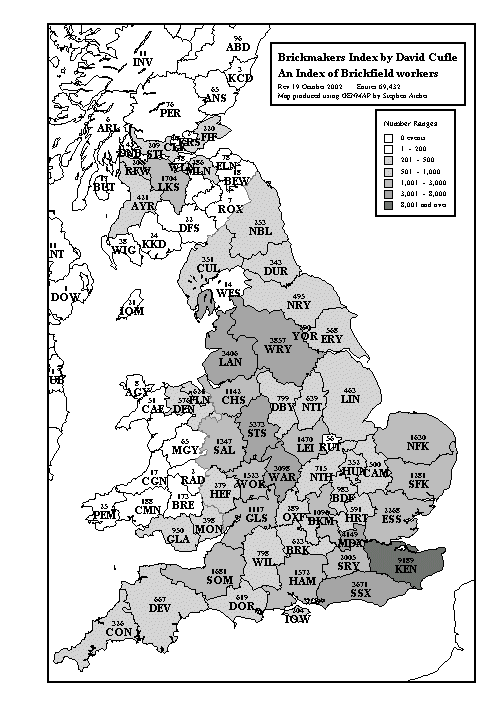Brickmakers Index
Introduction
An index of Brickfield workers and owners gathered from census, local histories and directories. Mainly England but with some entries from other areas in the United Kingdom and Ireland. There are also a few overseas entries for British born brickmakers. To enquire or offer information for inclusion send details with SAE or 3 IRC's to David Cufley, Windycroft, Herongate Road, Hextable, Kent BR8 7RQ. U.K.
The object of the project is to provide an index to Brickmakers and other Brickfield workers who frequently travelled from one brickfield to another, as the work was seasonal. It was not only bricks that were manufactured in the brickfields but also products such as tiles, chimney and flower pots, crocks, drain-pipes, sugar moulds and terra cotta ware. So the trade descriptions of the workers can sometimes be misleading. The index may also help because the brickfields around the London suburbs closed as the extent of building land caught up and overtook them. The index provides a list of brickfield addresses should you wish to know of the brickfields, brickyards, brickworks or brick kilns in any area (it may help with census searches).
Frequently the families of Brickmakers married members of other brickmaking families. The index can sometimes help with connecting these inter marriages.
The population of the brick industry in England and Wales is estimated according to J. H. Chapman's 'Economic History of Modern Britain' Vol. II, based on the factory inspectors reports of 1870 to be 1770 works with an average number of work-people per works of 12.7 which gives 22,479 people. M. Bowley in her book 'Innovations in Building Materials' states in the 1924 Census of Production for the whole brick and fireclay industry there were an average of 43.8 work-people for about 1600 production units, which equates to about 70,000 people. She also gives figures for the numbers employed in the brick industry in 1930 of 50,593 and in 1935 of 54,249.
The 1851 Census tally for Brickmakers and Dealers is given by the Registrar General's Office (RGO) as 31,168 people. In 1841 Frederick Spackman's 'An analysis of the Occupations of the people' gives a total of 14,383 for England which does not include labourers. The total for Kent is stated as 627, which seems very low when the breakdown shows 620 male workers and only 7 female workers. Again these figures exclude labourers. The number of men employed in the industry in Kent reached a maximum 5,119 in 1901 having risen from 3,335 in 1891, according to M.Winstanley's 'Life in Kent at the turn of the century'. The decline in the Kent industry can be seen by the fact that there were only 3,198 men employed in 1911. Many left to find alternative employment and hundreds were driven to emigrate, usually to Canada.
Some of these workers may have been your ancestors.
As an aid to understanding the trade a book list has been prepared which may be of help. Most of these publications are produced in Great Britain. If you would like a copy of this bibliography please send and SAE with donation for copying costs when submitting your brickmaker ancestor's details.
Brickmakers Index Distribution Map

The map has been produced using Stephen Archer’s GENMAP programme. (See 'Links to other family history pages').
As part of the Brickmakers index project maps of local areas and their associated brickfields can be generated.
